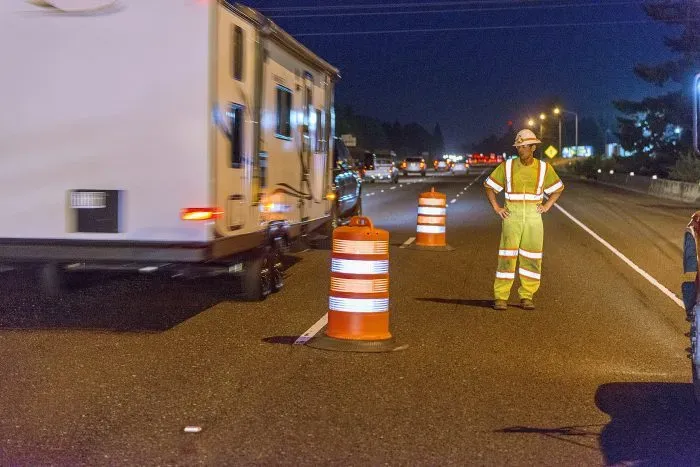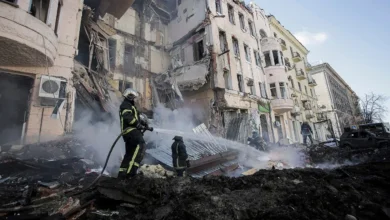New York Work Zone Protections: Enhancing Safety Measures

New York work zone protections are crucial for ensuring the safety of transportation workers who dedicate their lives to improving the state’s infrastructure. With Governor Kathy Hochul’s recent initiative to make the Automated Work Zone Speed Enforcement (AWZSE) program permanent, the landscape of highway worker safety is set for a significant transformation. This proposal not only aims to lower work zone speed limits but also to increase penalties for assaults against beleaguered workers. By addressing both the enforcement of speed limits and worker safety, New York transportation policies are gearing up for a safer future on the roads. As awareness grows, enhanced protections can help ensure that those on the front lines of roadwork can return home safely at the end of each day.
In recent developments, the safety measures for roadway construction sites in New York have garnered increased attention, emphasizing the need for robust protections for those working tirelessly to enhance public infrastructure. These measures, which include the permanent implementation of automated speed enforcement systems, reflect a growing commitment to safeguarding everyone involved in transportation projects. Such initiatives demonstrate a concerted effort to improve the well-being of highway laborers, while also promoting compliance with regulated speed limits in work zones. As these protective policies evolve, they highlight the significance of transportation worker safety in the broader dialogue around road safety and community responsibility. Ultimately, the ongoing efforts to fortify these safety protocols pave the way for a more secure environment for both workers and motorists alike.
New York’s Automated Work Zone Speed Enforcement Initiative
The Automated Work Zone Speed Enforcement (AWZSE) initiative in New York is designed to bolster highway worker safety by monitoring and enforcing speed limits in construction zones. By utilizing advanced camera technology, this program aims to deter speeding and promote safer driving behaviors among motorists in active work areas. The program’s effectiveness can be assessed via a notable reduction in vehicle speeds, which has been evidenced by a substantial decrease in issued ‘Notices of Liability’ for speed violations since its inception. This not only enhances the safety of construction crews but also encourages responsible driving habits ahead of ongoing transportation infrastructure improvements.
Governor Hochul’s proposal to expand the AWZSE program reflects a commitment to prioritizing work zone safety and the welfare of highway workers. With plans to extend this initiative to bridges and tunnels under the jurisdiction of the Metropolitan Transportation Authority, the measures are set to include enhanced penalties for violators. This comprehensive approach highlights the New York transportation policies aimed at safeguarding those who are on the front lines of infrastructure development and maintenance, ultimately fostering a safer commuting environment for everyone.
Enhancing Transportation Worker Safety in New York
Transportation worker safety remains paramount as New York State seeks to transform existing measures into permanent fixtures within its highway management framework. With increasing reports of assaults against traffic workers, the proposed legislative measures introduce stricter enforcement and consequences for such offenses. These new safety protocols will not only detour potential aggressors but also serve as a reminder to the public of the risks that workers in the highway sector face on a daily basis.
As part of a broader strategy to enhance worker safety, the collaboration between the NYSDOT and the New York State Thruway Authority is crucial. Through the AWZSE initiative, New York aims to radically improve working conditions for thousands of highway workers by minimizing hazards associated with high traffic volumes and speeding vehicles. This initiative instills a sense of responsibility among motorists, reinforcing the importance of adhering to work zone speed limits and fostering a culture of respect for those who dedicate their lives to ensuring public safety.
Increasing Penalties for Assaults on Transportation Workers
The legislative proposals regarding increased penalties for assaults on transportation workers signal New York’s dedication to maintaining a secure working environment for its labor force. Assaults against highway workers not only have physical repercussions but also contribute to a fearful atmosphere for those striving to keep the roads safe and functional. By strengthening legal consequences, the state aims to decrease violence and promote a more respectful interaction between the traveling public and those working tirelessly on transportation infrastructure.
With advocates supporting these enhanced deterrents, it is essential to recognize the human element behind these policies. Highway workers are essential to the safety and functionality of our infrastructure, and their work deserves both recognition and protection. As these legislative measures move forward, they will likely serve as a foundation for future efforts aimed at ensuring that workers can focus on their tasks without the threat of violence, leading to a healthier and more effective work environment.
The Role of Highway Worker Safety in Infrastructure Development
Highway worker safety is a critical factor that plays a significant role in infrastructure development. As construction projects continue to unfold throughout New York, ensuring the well-being of workers in active zones has become a priority. Enhanced safety measures, including the AWZSE program, contribute to minimizing the risks faced by laborers in traffic-heavy areas, thus fostering a more supportive environment for productivity. This intersection of safety and infrastructure is essential for the ongoing improvement of the state’s roads and bridges.
Furthermore, putting a spotlight on highway worker safety aligns with broader initiatives to improve general public awareness. Encouraging motorists to recognize the presence of construction teams leads to safer driving behaviors and overall better compliance with work zone regulations. With effective campaigns and robust enforcement mechanisms like the AWZSE in place, safety will inevitably be prioritized, cultivating a culture where both workers and commuters can coexist without risk.
Impact of Expanded AWZSE Program on Traffic Behavior
The expansion of the Automated Work Zone Speed Enforcement (AWZSE) program is expected to have a significant impact on traffic behavior, as evidenced by initial results since its launch. Studies indicate that areas with active speed enforcement see a marked decline in speeding incidents, promoting safer travel for both workers and drivers. These behavioral changes contribute to a broader narrative of compliance within work zones, encouraging the public to take work zone speed limits seriously and adhere to regulations that protect vulnerable workers.
By implementing such programs on a permanent basis, New York aims not only to sustain but to enhance these positive trends among traffic behavior. Education combined with enforcement can critically change the way motorists interact with work zones. With drivers becoming accustomed to reduced speed limits enforced by technology, safer highway environments are established, reducing the likelihood of accidents and promoting an overall culture of safety.
Integration of Technology in Work Zone Safety
The integration of technology within the work zone safety framework continues to reshape how New York approaches transportation safety measures. Leveraging systems such as Automated Work Zone Speed Enforcement, the state is pegging technological advancements to public safety initiatives. These systems serve not only as deterrents to speeding but also as educational tools that inform drivers about the potential consequences of unsafe driving. Technology’s role here underscores its importance in upholding worker safety as a crucial aspect of transportation policy.
Moreover, utilizing data collected through these technological measures allows for continuous improvement in safety protocols. The ability to analyze traffic patterns, identify repeat violations, and assess the effectiveness of speed enforcement provides invaluable insights. As NYSDOT works to refine these initiatives, the combination of technology, legislative support, and public awareness campaigns will inevitably create a more cohesive and safer environment for workers within highway work zones across New York.
Community Support for Highway Worker Protections
Community support is integral to the successful implementation of safety protections for highway workers in New York. As stakeholders rally behind the new proposals, advocacy from local residents, businesses, and organizations can amplify the message that the safety of construction crews is of utmost importance. Strengthening community awareness not only increases respect for workers but also encourages drivers to adjust their behavior when navigating through work zones, promoting an overall culture of safety.
Involving the community in safety discussions furthers public engagement and highlights the shared responsibility of road users and workers. Through campaigns that educate on the importance of maintaining safe speeds and the consequences of aggression towards workers, New Yorkers can create a supportive atmosphere that values safety on roadways. By fostering this collaborative environment, communities can play a pivotal role in ensuring that measures such as the AWZSE program effectively achieve their intended outcomes.
Long-term Goals of New York Transportation Policies
New York’s long-term goals regarding transportation policies are closely tied to enhancing worker safety and reducing the risk of accidents in work zones. By adopting permanent initiatives like the AWZSE program, state officials demonstrate a commitment to safeguarding labor and improving conditions across the board for those involved in highway maintenance and development. Such goals are crucial not only for worker welfare but also for improving the overall reliability of the transportation infrastructure.
Additionally, as the state maneuvers towards embracing evolving transportation challenges, proactive safety legislation will play a central role. By addressing issues before they escalate—be it through speed enforcement or stricter penalties for offenses—the goal of building a robust and safe transportation network becomes achievable. These long-term planning strategies aim to create an infrastructure landscape where workers can perform their roles without fear, ultimately leading to better roads for all New Yorkers.
Educating Drivers on Work Zone Awareness
Education is a critical element in promoting work zone awareness among drivers in New York. As infrastructure improvements continue, it is essential for motorists to understand the unique hazards present in work zones and the importance of adhering to safety protocols. Initiatives that focus on driver education regarding work zone speed limits and the presence of enforcement technology can significantly alter behaviors behind the wheel, making roads safer for everyone involved.
Efforts to enhance driver awareness not only lead to increased compliance with reduced speed limits but also foster a more respectful relationship between the traveling public and highway workers. Campaigns highlighting the stories and struggles of workers in construction zones can humanize the issue, encouraging drivers to slow down and exercise caution when approaching work areas. Through education, New York can cultivate a safer driving culture that places emphasis on mutual respect and safety for all road users.
Frequently Asked Questions
What are New York work zone protections and how do they affect highway worker safety?
New York work zone protections refer to the measures and regulations established to ensure the safety of highway workers while they perform their duties. This includes the implementation of Automated Work Zone Speed Enforcement (AWZSE) to monitor and reduce vehicle speeds in areas where workers are present, thus significantly enhancing the overall safety of transportation workers in New York.
How does Automated Work Zone Speed Enforcement enhance New York transportation policies?
Automated Work Zone Speed Enforcement enhances New York transportation policies by permanently enforcing lower speed limits in work zones, which contributes to reducing accidents and protecting highway workers. It serves as a critical tool to ensure that drivers adhere to safe driving practices, ultimately enhancing the safety of transportation infrastructure and the workers who maintain it.
What measures are included in New York’s proposals for transportation worker safety?
New York’s proposals for transportation worker safety include making the Automated Work Zone Speed Enforcement program a permanent initiative and increasing penalties for assaults against transportation workers. These measures are aimed at ensuring that workers can perform their tasks safely and return home without harm.
What impact has the AWZSE program had on highway worker safety in New York?
The AWZSE program has had a positive impact on highway worker safety in New York by reducing vehicle speeds in construction areas. Since its launch, there has been a notable decrease in the number of ‘Notices of Liability’ issued in zones where speed enforcement cameras are active, indicating that drivers are becoming more cautious and adhering to work zone speed limits.
Why are increased penalties for assaults against transportation workers important in New York?
Increased penalties for assaults against transportation workers are crucial in New York as they serve to deter violence and protect the safety of highway workers. This legislative measure underscores the importance of respect for workers’ safety and aims to create a safer working environment for those dedicated to maintaining the state’s transportation infrastructure.
How does New York State aim to improve safety in work zones through recent policies?
New York State aims to improve safety in work zones through recent policies by making the AWZSE program permanent, expanding its coverage to include more transportation areas, and strengthening laws against assaults on transportation workers. These initiatives are designed to foster a safer working environment and enhance the safety of drivers and transportation personnel alike.
What role do speed limits play in New York work zone protections?
Speed limits play a vital role in New York work zone protections as they are strictly enforced to ensure the safety of highway workers. By implementing lower speed limits in construction areas, the state aims to reduce the risk of accidents and injuries, creating a safer environment for both workers and motorists.
| Key Points |
|---|
| Governor Kathy Hochul proposed making the Automated Work Zone Speed Enforcement (AWZSE) pilot program permanent. |
| The AWZSE program will expand to cover bridges and tunnels managed by NYC’s Metropolitan Transportation Authority and NYS Bridge Authority. |
| Increased penalties are proposed for assaults against transportation workers. |
| The AWZSE program was launched in September 2021 to reduce vehicle speeds in highway work zones. |
| Since its launch, over 420,000 Notices of Liability have been issued, indicating its effectiveness. |
| There is evidence of decreased Notices of Liability in areas with active speed cameras, showcasing a slowdown in driver speeds. |
| NYSDOT Commissioner emphasizes that the proposed changes will enhance safety and respect for highway workers. |
Summary
New York work zone protections are being further enhanced with Governor Kathy Hochul’s proposal to make the Automated Work Zone Speed Enforcement (AWZSE) program permanent. This initiative not only aims to lower vehicle speeds in work zones but also seeks to expand protections by including critical infrastructure such as bridges and tunnels. By enforcing stricter penalties against assaults on transportation workers, New York is taking a proactive approach to safeguard those dedicated to maintaining road safety. These measures reflect a growing commitment to ensuring that highway workers can perform their essential duties without fear, thereby improving overall public safety during roadway construction and maintenance efforts.




